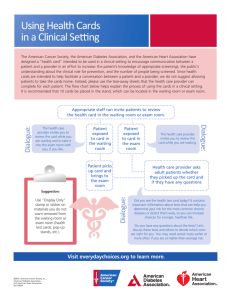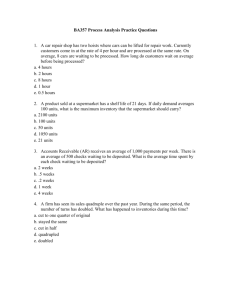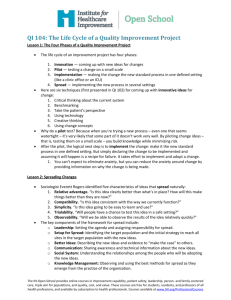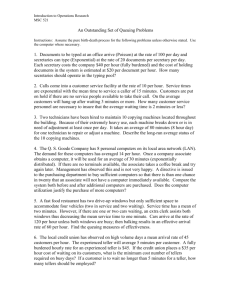Chapter 5 Capacity and Location Planning
advertisement
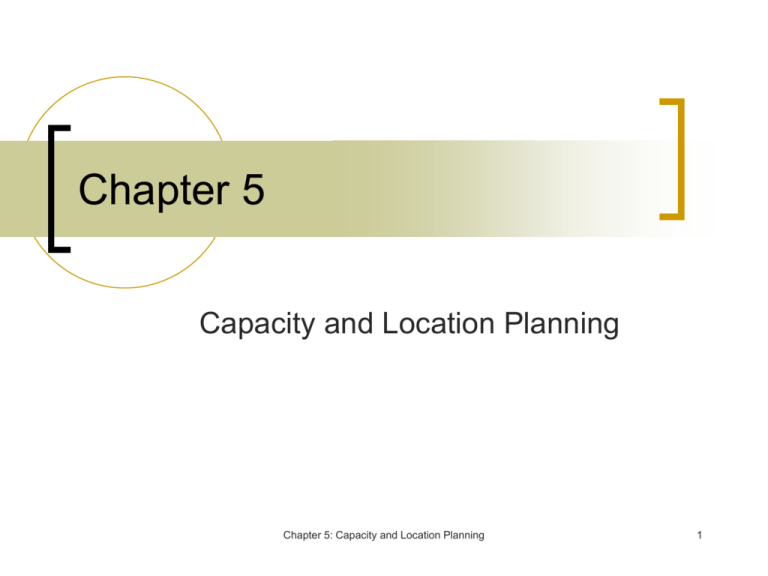
Chapter 5 Capacity and Location Planning Chapter 5: Capacity and Location Planning 1 Examples Chapter 5: Capacity and Location Planning 2 Burger King Highly variable demand During lunch hour, demand can increase from 40 to 800 hamburgers/hour Limited in ability to used inventory Facilities designed for flexible capacity During off peak times drive through staffed by one worker Chapter 5: Capacity and Location Planning 3 Burger King continued During lunch hour drive through staffed by up to five workers who divide up the duties Second window can be used for customer with special orders Average transaction time reduced from 45 to 30 seconds Sales during peak periods increased 50% Chapter 5: Capacity and Location Planning 4 Burger King continued Payroll costs as large as food costs Need to keep costs low but at same time meet highly variable demand BK-50 restaurant is 35% smaller and costs 27% less to build, but can handle 40% more sales with less labor Chapter 5: Capacity and Location Planning 5 Semiconductor Industry Learning from the steel industry Both industries require large and expensive factories 1980s steel industry started to abandon economies of scale justification and built minimills Chipmakers are now constructing smaller and more automated wafer fabs Chapter 5: Capacity and Location Planning 6 Semiconductor Industry continued Short life cycles make it difficult to recoup $2 billion it will cost to build wafer fab in 1998 Payback time is 22-30 month to conventional wafer fab versus 10 months for minifab Processing time can be reduced from 6090 days to 7 days. Chapter 5: Capacity and Location Planning 7 Mercedes-Benz Early 1990s investigated feasibility of producing luxury sports utility vehicle Project team established to find location for new plant Team charged with finding plant outside of Germany Team initially narrowed search to North America Chapter 5: Capacity and Location Planning 8 Mercedes-Benz continued Team determined that North America location would minimize combined labor, shipping, and components cost Plans indicated production volume of 65,000 vehicles per year and a breakeven volume of 40,000 vehicles Sites further narrowed to sites within US Close to primary market Chapter 5: Capacity and Location Planning 9 Mercedes-Benz continued Minimize penalties associated with currency fluctuations 100 sites in 35 state identified Primary concern was transportation cost Since half production was for export, focused on sites close to seaports, rail lines, and major highways Chapter 5: Capacity and Location Planning 10 Mercedes-Benz continued Worker age and mix of skills also considered Sites narrowed to sites in NC, SC, and AL These sites relatively equal in terms of business climate, education level, transportation, and long-term costs AL chosen due to perception of high dedication to the project Chapter 5: Capacity and Location Planning 11 Geographic Information Systems View and analyze data on digital maps Retail store in WI analyzed sales data on a map The map demonstrated that each store drew majority of sales from 20 mile radius Map highlighted area where only 15% of potential customers had visited one of its stores Chapter 5: Capacity and Location Planning 12 Sport Obermeyer Highly volatile demand Combined costs of stockouts and markdowns can exceed manufacturing costs Determine which items can and cannot be predicted well Products that can be predicted produced furthest in advance Increased its sales of fashion skiwear 50% to 100% over 3 year period in 1990s Chapter 5: Capacity and Location Planning 13 Insights Capacity planning applies to both manufacturing and service organizations Capacity options can be categorized as short-term or long-term Changing staffing level is short-term Building new minifab is long-term Chapter 5: Capacity and Location Planning 14 Insights continued Semiconductor industry illustrates the enormous cost often associated with expanding capacity Shorter product life cycles add further complications Volatile demand can further complicate capacity planning Chapter 5: Capacity and Location Planning 15 Introduction Capacity needs determined on the basis of forecast of demand. In addition to determining capacity needed, the location of the capacity must also be determined. Mercedes-Benz example illustrates that location decisions are often made in stages. Chapter 5: Capacity and Location Planning 16 Sport Obermeyer Highly volatile demand Combined costs of stockouts and markdowns can exceed manufacturing costs Determine which items can and cannot be predicted well Products that can be predicted produced furthest in advance Increased its sales of fashion skiwear 50% to 100% over 3 year period in 1990s Chapter 5: Capacity and Location Planning 17 Forecasting Purposes and Methods Chapter 5: Capacity and Location Planning 18 Primary Uses of Forecasting To determine if sufficient demand exists To determine long-term capacity needs To determine midterm fluctuations in demand so that short-sighted decisions are not made that hurt company in long-run To determine short-term fluctuations in demand for production planning, workforce scheduling, and materials planning Chapter 5: Capacity and Location Planning 19 Forecasting Methods Informal (intuitive) Formal Quantitative Qualitative Chapter 5: Capacity and Location Planning 20 Forecasting Methods Chapter 5: Capacity and Location Planning 21 Qualitative Methods Life cycle Surveys Delphi Historical analogy Expert opinion Consumer panels Test marketing Chapter 5: Capacity and Location Planning 22 Quantitative Methods Causal Input-output Econometric Box-Jenkins Autoprojection Multiplicative Exponential smoothing Moving average Chapter 5: Capacity and Location Planning 23 Choosing a Forecasting Method Availability of representative data Time and money limitations Accuracy needed Chapter 5: Capacity and Location Planning 24 Long-Term Capacity/Location Planning Chapter 5: Capacity and Location Planning 25 Terminology Maximum rate of output of the transformation system over some specified duration Capacity issues applicable to all organizations Often services cannot inventory output Bottlenecks Yield (or revenue) management Chapter 5: Capacity and Location Planning 26 Long-term Capacity Planning Unit cost as function of facility size Economies of scale Economies of scope Chapter 5: Capacity and Location Planning 27 Envelope of Lowest Unit Output Costs with Facility Size Chapter 5: Capacity and Location Planning 28 Demand and Life Cycles for Multiple Outputs Demand Seasonality Output Life Cycles Chapter 5: Capacity and Location Planning 29 Anti-cyclic Product Sales Chapter 5: Capacity and Location Planning 30 Forecast of Required Organizational Capacity from Multiple Life Cycles Chapter 5: Capacity and Location Planning 31 Timing of Capacity Increments Chapter 5: Capacity and Location Planning 32 Location Planning Strategies Chapter 5: Capacity and Location Planning 33 Capabilities and the Location Decision Often driven too much by short-term considerations wage rates exchange rates Better approach is to consider how location impacts development of longterm capabilities Chapter 5: Capacity and Location Planning 34 Six Step Process Identify sources of value Identify capabilities needed Assess implications of location decision on development of capabilities Identify potential locations Evaluate locations Develop strategy for building network of locations Chapter 5: Capacity and Location Planning 35 Stage 1: Regional-International Minimize transportation costs and provide acceptable service Proper supply of labor Wage rates Unions (right-to-work laws) Regional taxes, regulations, trade barriers Political stability Chapter 5: Capacity and Location Planning 36 Stage 2: Community Availability of acceptable sites Local government attitudes Regulations, zoning, taxes, labor supply Tax Incentives Community’s attitude Amenities Chapter 5: Capacity and Location Planning 37 Breakeven Location Model Chapter 5: Capacity and Location Planning 38 Stage 3: Site Size Adjoining land Zoning Drainage Soil Availability of water, sewers, utilities Development costs Chapter 5: Capacity and Location Planning 39 Weighted Score Model Wi = importance of factor i Si = score of location being evaluated on factor i i = an index for the factors Total weighted score = WiSi i Chapter 5: Capacity and Location Planning 40 Locating Pure Service Organizations Recipient to Facility facility utilization travel distance per citizen travel distance per visit Facility to Recipient Chapter 5: Capacity and Location Planning 41 Short Term Capacity Planning Chapter 5: Capacity and Location Planning 42 Bottlenecks in Sequential Operations Chapter 5: Capacity and Location Planning 43 Efficiency and Output Increase when Machines are Being Added Chapter 5: Capacity and Location Planning 44 Product and Service Flows Chapter 5: Capacity and Location Planning 45 Process Flow Map for a Service Chapter 5: Capacity and Location Planning 46 Implementing the Theory of Constraints Identify the system’s constraints Exploit the constraint Subordinate all else to the constraint Elevate the constraint If constraint is no longer a bottleneck, find the next constraint and repeat the steps. Chapter 5: Capacity and Location Planning 47 Relationship between Capacity and Scheduling Capacity is oriented toward the acquisition of productive resources Scheduling related to the timing of the use of resources Chapter 5: Capacity and Location Planning 48 Gantt Charts for Capacity Planning and Scheduling (Infeasible) Chapter 5: Capacity and Location Planning 49 Gantt Charts for Capacity Planning and Scheduling (Feasible) Chapter 5: Capacity and Location Planning 50 Short-Term Capacity Alternatives Increase resources Improve resource use Modify the output Modify the demand Do not meet demand Chapter 5: Capacity and Location Planning 51 Increase Resources Overtime Add shifts Employ part-time workers Use floating workers Subcontract Chapter 5: Capacity and Location Planning 52 Improve Resource Use Overlap or stagger shifts Schedule appointments Inventory output Backlog demand Chapter 5: Capacity and Location Planning 53 Modify the Output Standardize the output Have recipient do part of the work Transform service operations into inventoriable product operations Cut back on quality Chapter 5: Capacity and Location Planning 54 Demand Options Modify the Demand change the price change the promotion Do Not Meet Demand Chapter 5: Capacity and Location Planning 55 Capacity Planning for Services Large fluctuations in demand Inventory often not an option Problem often is to match staff availability with customer demand May attempt to shift demand to off-peak periods Can measure capacity in terms of inputs Chapter 5: Capacity and Location Planning 56 The Learning Curve Chapter 5: Capacity and Location Planning 57 Background In airframe manufacturing industry observed that each time output doubled, labor hour per plane decreased by fixed percentage Chapter 5: Capacity and Location Planning 58 Learning Curve Function M = mNr M = labor-hours for Nth unit m = labor-hours for first unit N = number of units produced r = exponent of curve = log(learning rate)/0.693 Chapter 5: Capacity and Location Planning 59 Typical Pattern of Learning and Forgetting Chapter 5: Capacity and Location Planning 60 Queuing and the Psychology of Waiting Chapter 5: Capacity and Location Planning 61 Waiting-Line Analysis Mechanism to determine several key performance measures of operating system. Trade-off two costs cost of waiting cost of service Chapter 5: Capacity and Location Planning 62 Waiting Line Analysis Chapter 5: Capacity and Location Planning 63 Principles of Waiting Unoccupied time feels longer than occupied time. Pre-service waiting feels longer than inservice waiting. Anxiety makes waiting seem longer. Uncertain waiting is longer than known, finite waiting. Chapter 5: Capacity and Location Planning 64 Principles of Waiting continued Unexplained waiting is longer than explained waiting. Unfair waiting is longer than fair waiting. Solo waiting is longer than group waiting. The more valuable the service, the longer it is worth waiting for. Chapter 5: Capacity and Location Planning 65 Chapter 5: Capacity and Location Planning 66

